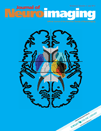Vertebral Artery Anomaly Causing C2 Suboccipital Neuralgia, Relieved by Neurovascular Decompression
Conflict of Interest: None.
J Neuroimaging 2013;23:421-424.
ABSTRACT
We report imaging and surgical findings of a symptomatic 40-year-old male with an anomalous left vertebral artery. MR, CT myelography, angiography, and intraoperative photos demonstrate the vertebral artery entering the thecal sac at the C1-C2 intervertebral foramen and compressing the dorsal C2 nerve rootlets against the cord. Open microvascular decompression alleviated the patient's long-standing suboccipital and posterior cervical neck pain. An embryologic review of the vertebral and lateral spinal artery systems reveals possible developmental explanations for this variant. Intradural course of the vertebral artery at C2 is one of the few symptomatic developmental vertebral artery anomalies. Recognition of this condition is important because surgical intervention can alleviate associated neck pain.




